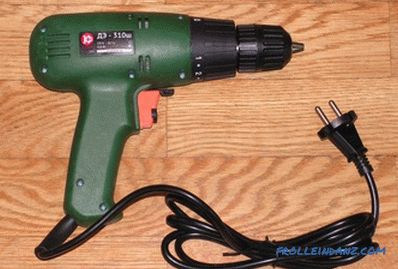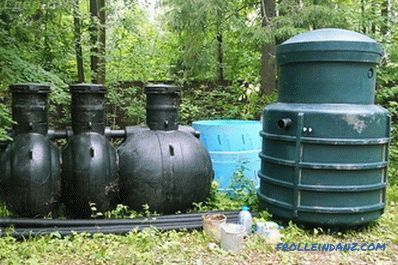All household drains of numerous apartment sanitary devices are discharged through sewer pipes. The developers undertake their installation, but homeowners have to deal with the repair and replacement of utilities. Sometimes a new building requires laying sewers from scratch. The installation work can be entrusted to plumbers, but if there is free time and a desire to save money, then the sewage system in the apartment with its own hands is also mounted on its own. The main thing is to know how to carry out the pipe installation and to connect the plumbing.
The first stage is planning
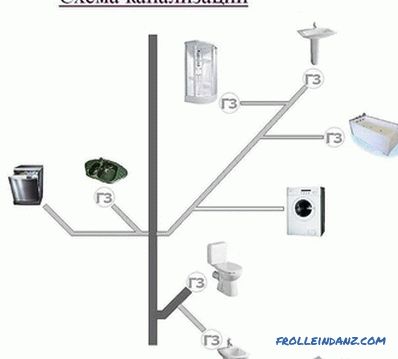 Sewage scheme for an apartment
Sewage scheme for an apartment
Before distributing pipes and plumbing installation, it is necessary to plan the sewer system. The scheme includes the following elements:
- plumbing fixtures: toilet, sink, shower, bath, dishwasher, bidet;
- length and diameter of pipes;
- distance from walls to plumbing and pipes;
- riser location;
- diameter of siphons for connecting sinks and baths;
- number of connecting elements (fittings);
- system tilt angle;
- location of audit points.
If you are not planning to connect new points, then you can not change the existing sewer layout. This will simplify the calculation of the required material. The length of all pipes is measured in situ; if they pass through a wall, then the size of each section will be required.
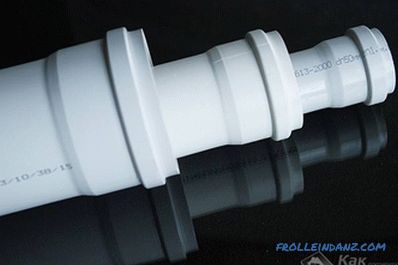 Sewer pipes
Sewer pipes
The diameter of the sewer pipes is not chosen arbitrarily, there are recommendations for their size :
- for the riser section - 110 mm;
- for the toilet bowl - 110 mm;
- for the bathtub, washing and other appliances - 50 mm.
A 32 mm pipe is sometimes used to connect some devices.
The slope also does not have to be chosen independently, pipes with a diameter of up to 50 mm are arranged at an angle of 3º, and 110 mm are set at 2º. This means that on a plot of 1 meter the slope changes by 3 and 2 cm, respectively. The correct location of the line ensures the movement of water in the self-flowing system.
The choice of material
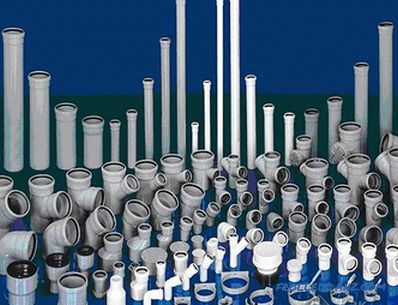 Plastic sewer pipes
Plastic sewer pipes
Sewerage in the apartment is made of plastic , cast iron pipes work harder. Polymeric pipes of three types are used: polyvinyl chloride, propylene and polyethylene. These products are similar in appearance and properties:
- a smooth surface that does not accumulate deposits;
- strength, resistance to corrosion;
- light weight;
- durability;
- installation does not require welding.
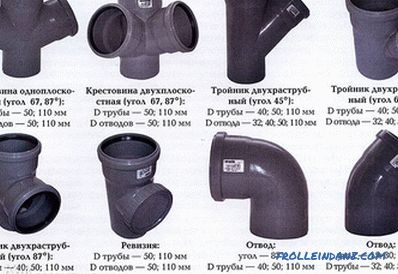 Adapters to sewer pipes
Adapters to sewer pipes
Special elements are required to connect pipes: outlets, tees , transitions from metal cuffs. It is better to purchase all the necessary material from one manufacturer, this guarantees the accuracy of the coincidence of all diameters. Sealing the joints will require silicone grease, it is also bought in advance. So, for work we will need:
- plastic pipes with diameters of 50 and 110 mm;
- fittings;
- sealing cuffs;
- clamps made of plastic, selected by the pipe section;
- revision hatch, which is installed on a common riser;
- silicone sealant.
Tools:
- punch;
- Bulgarian;
- hammer;
- hacksaw;
- chisel;
- adjustable wrenches of various sizes.
Dismantling of the old system
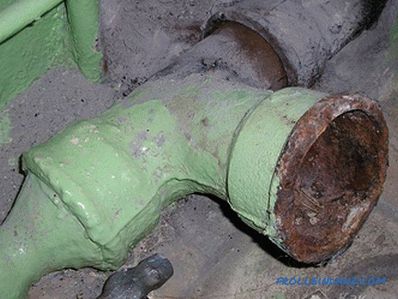
The sewage system is started from the riser. This is the most difficult section, it runs through drains from neighboring apartments, so for the time of pipe replacement, neighbors should be asked not to use the sewer for some time. Dismantling is as follows:
- Access to the place of docking of the riser with the adjacent section opens. This may require breaking a portion of the slab.
- A part of a cast-iron pipe is cut by a grinder. If you can not completely cut through, then it can be broken with a hammer. Work must be carried out carefully, as a broken-off piece of pipe may remain inside and block the entire pipe.
- A tee is installed at the bottom of the riser near the floor. The straight plastic pipe chosen for the riser is connected at the top with the remainder of the cast-iron pipe using a transition sleeve. Fastening with a tee is carried out by a bell. The tightness of the joint provides a rubber ring and silicone sealant.
- The pipe is attached to the wall with hose clamps. In the vicinity of the sockets, the pipe is fixed rigidly, in other places the fixation is floating.
Having completed the installation of the riser, proceed to the layout.
Installation of sewage system
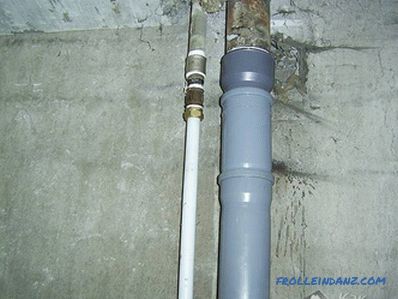 Replaced riser
Replaced riser
All sanitary fixtures are disconnected from pipes to be dismantled. After removing the old system, the layout of the new highway is marked.When installing the pipeline, it is preferable to straight sections, bends and turns, which provoke blockages, should be the minimum number. Proper installation of sewers with a small number of connections and sustained tilt angle ensures self-cleaning of the system. With each flush, the stream carries the remainder of the previous stream.
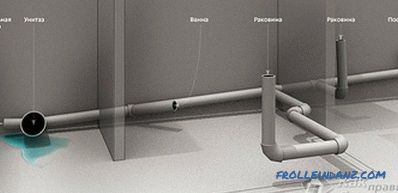 Sewage slope
Sewage slope
You can organize the marking of the slope of the pipes using a line on the wall or a cord attached to the highest and lowest point of the sewer system. According to this marking, the installation location of the fastener is determined, for pipes Ø 50 mm, clamps are put through 50 cm. To relieve tension in the pipes, two types of fastening must be combined:
- rigid - the pipe is fixed by a clamp with a rubber gasket;
- floating - fasteners allow the pipe to move, runs without a rubber insert.
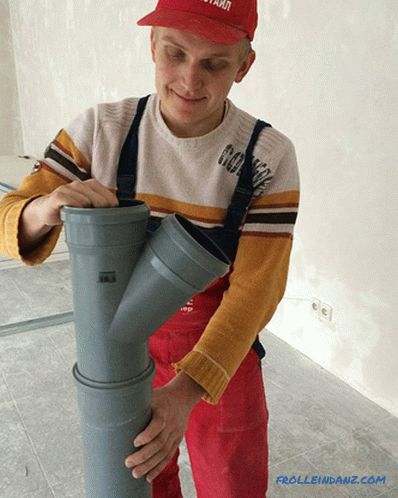 Connecting plastic sewers
Connecting plastic sewers
Before installing the pipes, you must remove the chamfer and clean it edges so that there is no burrs. The inner surface of the pipe and fitting should be clean and dry. When making the connection, the end of the pipe is inserted into the socket until it is tightly abutted. To enhance the tightness of the rubber ring is applied silicone grease. Beaters should be located along the water flow. During operation of the sewage system, temperature deformation of the plastic occurs. So that the seam does not lose tightness when expanding the material, a gap of 1 cm is left. This is done like this: the pipe is inserted into the socket to the stop, then a 10 mm mark is made and the part is retracted back to this mark.
In order not to have to redo the finished system, it is worth making a trial installation without tight connections. Once you are sure that the installation is correct and that all parts are present, you can complete the assembly.
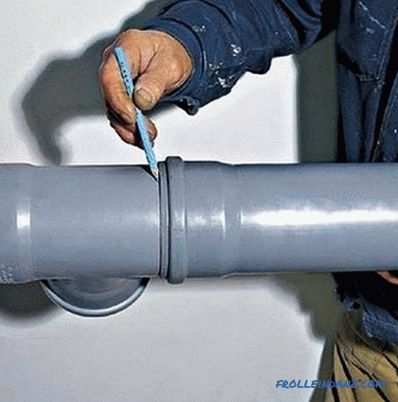 Pipe marking before cutting
Pipe marking before cutting
Mounting recommendations:
- Only straight plastic pipes can be cut. Most often at home the incision is made with a hacksaw, necessarily at an angle of 90º.
- If you need to make a turn, it is better to use two 45º taps. They do not smash moving drains so drastically; therefore, they are clogged less frequently.
- The toilet is joined first to the system, then the rest plumbing fixtures.
- In difficult areas, a segment called a revision is established. It has a hole covered with a rubber cap through which you can inspect the inner surface of the pipe.
- Part of the plumbing is connected directly to the sewage system, but there are appliances that require the installation of a siphon. This is a device with a bend in the form of a knee, inside of which there is always water for a hydraulic seal. Siphon does not allow unpleasant odors from the sewer system to spread indoors.
- Sewage wiring is performed not only along the walls, but also in the trough. Before being placed in the wall, the pipes are wrapped in a soft material to reduce noise. To prevent cement from entering the joints, they are stuck with tape. In strobah tubes are fixed in a floating way.
- The ends of horizontal bends are closed with plugs.
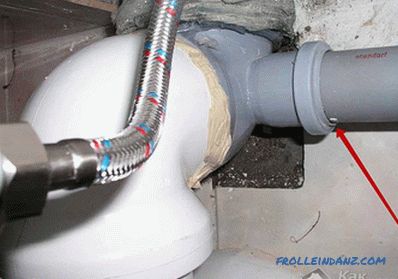 The leakage of the collected sewage should be repaired
The leakage of the collected sewage should be repaired
After installation, you should check the tightness of the assembled system to all parts of the layout of the apartment and at the junction with the riser. The reliability of the docking of the new riser with the neighbor pipe is checked after the water is drained in the upper apartment. To check, water is drawn into the bathroom, and then the stopper is removed, both taps are opened in the kitchen, and the toilet is drained. Reliability of joints is easy to assess - they should all be dry.
Video
This video shows how to replace the residential cast-iron sewage wiring in stalinka on plastic:
Photos
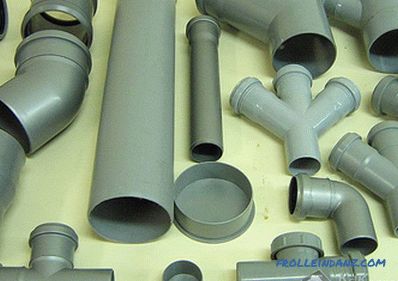 Sewer pipes and fittings
Sewer pipes and fittings
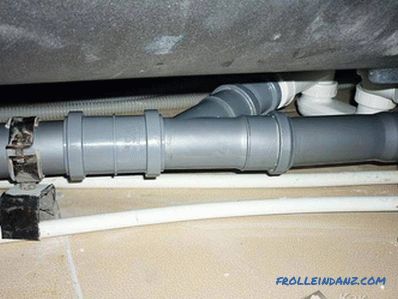 Installation of plastic sewer pipes in the bathroom
Installation of plastic sewer pipes in the bathroom
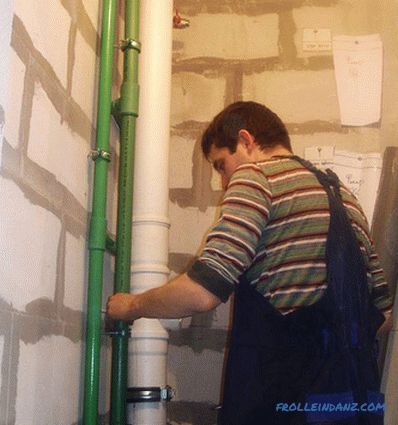 Replacing the riser
Replacing the riser
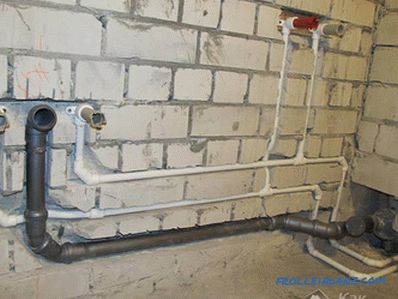 Pipe slope
Pipe slope
 Connection of cast iron with plastic
Connection of cast iron with plastic
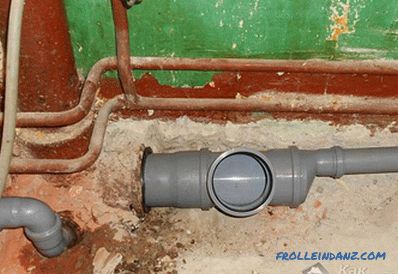 Input of a plastic pipe into the tee of a cast-iron riser
Input of a plastic pipe into the tee of a cast-iron riser
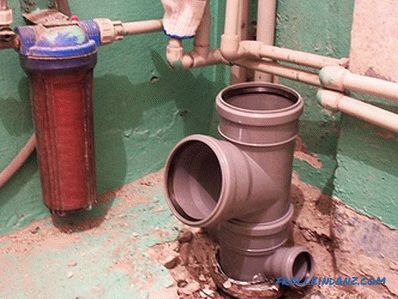 Replacing cast iron with plastic
Replacing cast iron with plastic
 Example of rotten cast-iron sewage
Example of rotten cast-iron sewage
